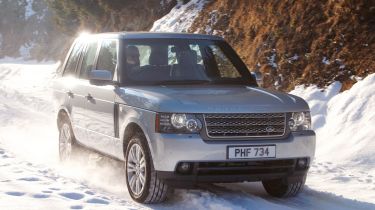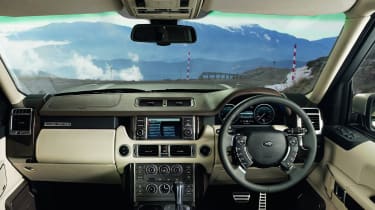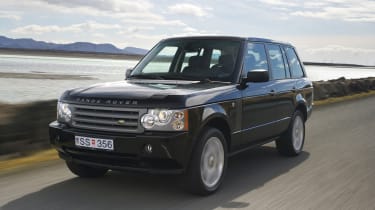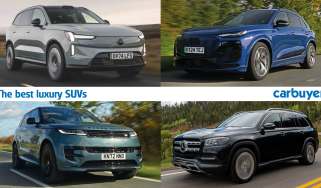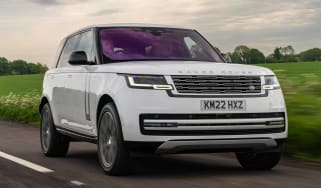Used Range Rover buying guide: 2002-2013 (Mk3)
The Range Rover is amongst the world’s most desirable SUVs and falling prices mean the Mk3 is now becoming a used bargain
One of the first models to combine luxury with go-anywhere abilities, the Range Rover has become an iconic vehicle that appeals to a wider audience than ever before. While very few owners will cross moorlands or tow a yacht, the Range Rover’s smooth ride, luxurious interior and unique styling all add to its desirability.
This comes at a price, though, with the latest model costing more than £75,000. There’s an alternative, however, thanks to the previous model being available from just £5,000 if you don’t mind buying an older vehicle. This is due to it being on sale from 2002 to 2013, so while earlier versions might miss out on the latest technology, you can still land a desirable and highly capable car for the money.
You need to go into ownership with your eyes open though, because the Mk3 Range Rover doesn’t exactly have the best reliability record, so you’ll either need to be handy with a spanner or happy to let the local Land Rover dealership work on it when issues crop up. In this guide, we’ll highlight some of the main pros and cons of this motoring giant.
Five-year-old examples are available from between £25,000 and £35,000 depending on specification. Visit our sister site BuyaCar for the latest used Range Rover prices and deals.
First launched in 2002, the previous generation of Range Rover remained on sale right up until 2013. While this is a longer-than-average lifespan, the Range Rover received significant updates over the years, so it’s important to know which model year you’re considering to ensure you get the engine, gearbox and specification you want.
More reviews
Despite its rugged roots in Land Rover’s utilitarian heritage, this Range Rover really cemented the model’s reputation as a luxury car as well as a hugely capable off-roader, rather than an off-roader that’s also impressively luxurious. The combination of the raised driving position with the off-road ability, the luxurious interior and hugely impressive ride meant it proved hugely popular with buyers in the city as well as the country.
At launch, you could have the car with either a 3.0-litre six-cylinder diesel or a 4.4-litre naturally-aspirated petrol V8. Both were sourced from Land Rover’s previous owner BMW. Just three years later, two new petrol V8s – a 4.2 and 4.4-litre from Jaguar – were called in to replace the BMW petrols. In 2006, there was a much-needed update to the diesel range, too, moving from the somewhat underpowered straight-six diesel to the brilliant 3.6-litre diesel TDV8, while Jaguar’s new supercharged 5.0-litre petrol V8 replaced the other two petrol V8s, quickly becoming the only petrol option in the range. Finally, in 2010, the last change to the engine line-up was made, increasing the TDV8‘s displacement from 3.6 to 4.4 litres.
Over the course of this Range Rover’s life, there were various interior and exterior updates, including a major one in 2006. This saw the introduction of new front and rear bumpers, new lights all round and a new infotainment system inside.
Speaking of the interior, this is where the ‘Rangie’ really earns its luxury-car stripes, with wood and leather abounding, as well as some high-quality metal trim. This generation of Range Rover is taller and more upright than the current model, so there’s slightly less room in the rear seats than in its replacement, but there’s still plenty back there for most people. Despite the leviathan proportions, there’s no option of seven seats – you’ll need to go for the slightly cheaper and racier Range Rover Sport (based on the same underpinnings as the even more utilitarian Discovery) if you need a third row of seats. This does mean, however, that there’s a huge boot.
What is the best Range Rover Mk3 version?
Deciding which Range Rover is best for you really depends what your budget is and what age of car you’re aiming for, as the range of engines and trim levels available changed several times throughout the model’s life
If you’re looking at older examples at the cheaper end of market, it’s best to go for the TD6 diesel in Vogue trim. It’ll cost less to run than the petrol and Vogue is as luxurious as you can get. We’d recommend the diesels at all ages. They won’t be cheap to run in the grand scheme of things, but they seem frugal when compared to the incredibly thirsty petrols, plus they’re very smooth and refined – especially the newer TDV8. Vogue SE models have all the luxurious equipment you could want from a car like this, too.
If running costs aren’t a concern, the V8 petrols are silky smooth and actually very well suited to the Range Rover’s relaxed nature – just be ready to fork out a lot of money on petrol.
Running costs
Even if you go for a diesel, you’d be naïve to think the Range Rover is going to be a cheap car to run. The diesels – both the TD6 and newer TDV8 – will return around 25-30mpg if you’re lucky, while the petrols will struggle to get more than 20mpg, so be prepared to spend a lot of time and money at the petrol station if you go for one.
The Range Rover sits in high tax bands, too, so you’ll be paying anything between £305 and £535 a year in Vehicle Excise Duty (VED), or road tax.
Services are due every 10-15,000 miles or 12-15 months, and they tend to alternate between minor and major. They generally cost between £400-£600, depending on what needs to be sorted and if anything else crops up.
What to look out for
Unfortunately, the Range Rover has never had a glowing reputation for solid reliability and this version is no different. It’s important to note that even the youngest examples on the market will now be out of manufacturer’s warranty, as the car came with three-year/unlimited-mileage cover when new.
A common source of problems for Range Rover owners is the car’s electrics. Check that the locks, windows, seats and mirrors all work as they should when you’re looking around a potential purchase.
Gearboxes can fail at around 100,000 miles, costing around £5,000 to fix, while the fuse board can fail, too. There have been issues with the dashboard as well, so make sure the instruments and dials are all working as they should. Repairing these can cost around £1,000.
The front differential can fail after just 40,000 miles, while the air suspension has been known to give up, often at unexpected times. If the car has been used for towing or off-roading, check that the brakes, transmission and suspension are all in good working order.
In terms of recalls, this Range Rover was first affected in 2002 due to a potential short-circuit issue. ESP issues caused a recall in 2004, while cars built between August and November 2004 were recalled for a faulty in-dash TV system. In 2005, cars were checked for a gearbox fault, while there were potential brake-fluid leaks on cars built between July 2002 and October 2006. A further recall hit in 2009, due to problems with the windscreen bonding. There were three more recalls for this generation of Range Rover, with cars built between March 2005 and July 2012 being recalled to fix a possible braking problem, while two separate recalls – for cars built between November 2012 and January 2013, as well as March 2012 through to January 2013 for the same electronic issue which increased the risk of fire.
Should I buy one?
While earlier examples of this version of the Range Rover have some reliability issues, the strong appeal of its badge, the luxurious interior and general prestige can’t be ignored. If you can stomach the high running costs, few cars provide a greater sense of occasion than a Range Rover. The neighbours will be suitably impressed, too, even if your car didn’t actually cost that much to buy, especially when you consider how expensive it would have been when new.
When the Range Rover Mk3 first went on sale in 2002, it started at around £50,000. Today, used examples range significantly in price, however you can expect to pay from between £5,000 to £30,000.
For up to date deals on used Range Rover Mk3 models, visit our sister site buyacar.co.uk.
